Govardhan Parvat, Yamuna, and Braj Bhumi – are the only three things that have existed since the time of Sri Krishna. So tells me, the boatman who took me on a boat ride on the Yamuna in Mathura. It was repeated by every priest I spoke to, every learned man I interacted with in Braj Bhumi. Everything else you see belongs to the Bhaktas – the devotees of Radha Krishna. Not that bhaktas are treated any less in Braj. Let’s go on the Govardhan Parvat Parikrama.

At the holy village, the hill and every stone of this hill are sacred. You see the stones being worshipped everywhere. Somewhere they are decorated and given a human feel with eyes and makeup, at another place they are worshipped just like that. Priests will show you the signs of feet or cows or Radha Krishna on these stones. They believe these stones have seen Radha Krishna do their Leela and they carry their imprints. Each stone is treated like Krishna and Radha.
They say the stones should not be taken out of Braj Bhumi. You will hear stories of people who tried to smuggle the stones out of Braj Bhumi and met with disaster. Ecology is best preserved with rituals I guess.
A Parikrama or circumambulation of the Parvat is very popular among the devotees. Around the year you can see people doing Parikrama. This time in Braj Bhumi, I decided to do the Govardhan Parvat Parikrama. I did it on an e-rickshaw. The first thing I discovered was the different types of Parikrama that you can do.
Different Types of Govardhan Parvat Parikrama

Walking Parikrama
This is the most common and probably the easiest way to do Parikrama. You start at a point and walk in the clockwise direction with the hill always on your right and finish at the same point. Depending on how fast you walk, walking Parikrama can be done in 6-8 hours not counting any rest stops you take.
Doodh Parikrama
In this Parikrama, you hold a pot of milk in your hand as you walk or drive around Govardhan Parvat. You keep offering the milk continuously. Most of the time, people make a small hole in the pot and just hold it as they move. As you walk, you can see the lines of milk on the path.
Sohni Seva Parikrama
This is a parikrama done with a broom, where you clean as you do the Parikrama. The name of this parikrama itself says – the one that makes the place beautiful. How incredible! Imagine a built-in system to make sure that a place that is visited and worshipped by so many cleans itself.
Dandvat Parikrama
Dandvat means doing the Parikrama with your whole body. You lie on the floor with both hands, feet, knees, chest, and forehead touching the ground. You mark where your hands reach with a stone and then stand at the same place to again touch your whole body to the ground. It is very difficult. After each Dandvat you do a Pranam. People who do this regularly take about 8-10 days to finish it. They do a part of it every day.
Couple Dandvat Parikrama
In a great example of Ardhnarishwara, many couples do the Dandvat Parikrama together. Alternate Dandvats are done by the husband and the wife. This reduces the effort spent by half. I saw many couples doing a Dandvat, where the wife starts from where the husband’s hands reach, and then, the husband stands where the wife’s hand touches the ground.
108 Dandvat Parikrama
This will amaze you. In this, the devotee carries 108 stones with him. He does 108 Dandvats at the same place before moving on. I saw many Sadhus doing this Dandvat on the Parikrama. You have to see them believe, how hard it is. It takes years for one Parikrama to be done. You cannot move more than 5-10 meters in a day. You will see many of these piles of stones throughout the Parikrama path. It tells you the number of people undertaking this. It seems they would be doing this for most of their lives. Where else have you seen such dedication?
How long is Govardhan Parvat Parikrama?
The whole parikrama route passing by the various temple, ponds, and groves is about 21 km.

The Soft Earth walking path on most of the route allows you to walk easily, even barefoot, like most walk. This path was pretty clean and broad in most places. Only when the villages pop up, do you need to walk on the tar road.
The route is pretty easy to do, with literally no ups and downs. In many places, you have the option to walk along the road or walk through the trees close to the hill.
Govardhan Parvat Parikrama Route
It is a circular route that goes around the Parvat. You can start and end the Parikrama from anywhere on the route, with your Sankalp. I will narrate as I did it.
Daanghati Mandir
Most people coming from Mathura start the Parikrama from Daanghati Mandir. The temple façade showcases the Krishna carrying Govardhan Parvat on his little finger is relatively news.
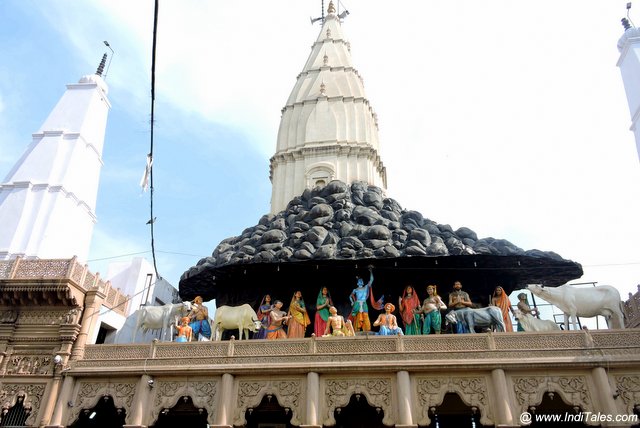
Daanghati temple gets its name from the Daan or tax that little Krishna used to collect from Gopikas who wanted to do Puja. Once they gave Radha to him as Daan, which is precisely what he wanted.
It is actually a temple complex with many small temples. A rock is decorated in a way that it looks alive and human. This is what is worshipped everywhere in the village.
Laxmi Narayan Temple

Opposite the Daanghati temple is a lovely Laxminarayan temple in stone, built-in 1903 by a wealthy family of Hathras. Next to the police station, there is a small area marked for Govardhan Puja which is done every morning and evening. This is a rather modern structure.
Mansi Ganga
Mansi Ganga is a sacred lake in the middle of the village. It is said that once Nand and Yashoda, the foster parents of Sri Krishna wanted to visit Ganga. On their way, they halted here for the night. By morning, Krishna brought the Ganga here from his mind, and it got the name Mansi Ganga.

This lake is surrounded by many temples. As I took a walk around the lake, I could see the rocks being worshipped outside every home, in every temple, and under every tree. The lanes around Mansi Ganga have lovely little houses that take you back in time. I saw intricate paintings under the arches of some of the temples. The lake is surrounded by many big and small temples. Let me mention some of them for you:
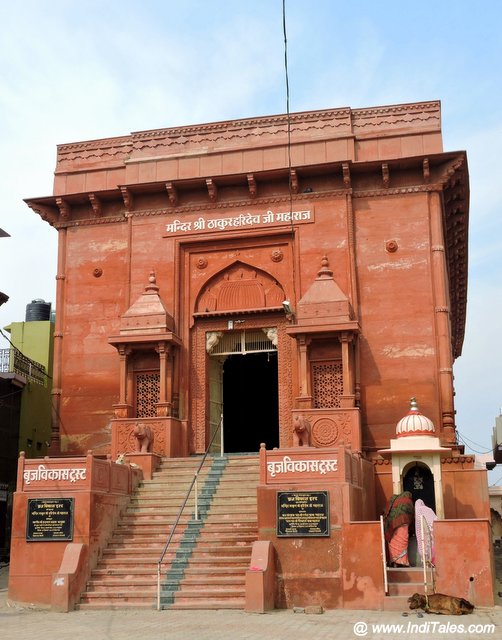
Thakur Hari Dev Ji Mandir
A narrow lane led me to Thakur Hari Dev Ji temple in red sandstone. It is believed that it is at this spot that Sri Krishna stood when he held the Govardhan Parvat on his finger.
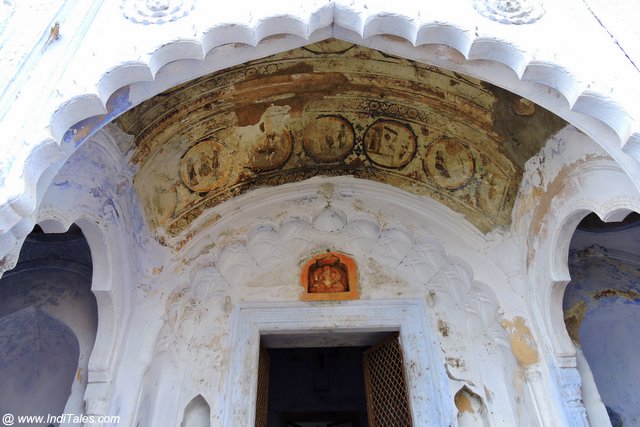
Brahma Kund
This is a small Kund on the periphery of Mansi Ganga which seems to be recently renovated and then immediately neglected.
Chakreshwar Mahadev Temple
This is the most incredible temple I saw on the whole trail. It is a Shiva temple with 5 Shivalings in the shape of a Chakra. A carved stone behind retells the story of Krishna carrying the Govardhan Parvat on his finger. The story goes that when the Parvat was lifted, the water started gathering in the pit. Shiva appeared in the form of a Chakra or a wheel to flush it out. This temple commemorates that.
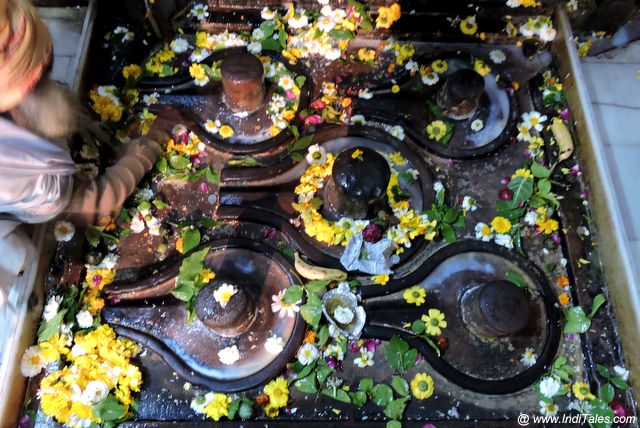
I found the formation of the Chakra with five ancient Shivalingas very unique as if the stone sculpture behind it. I could not gather all that is on the sculpture but there is a yantra with 9 boxes, there is Brahma on it and the top panel depicts the Govardhan lifting scene. There is a conch carved and a figure that looks like Hanuman.

A Nandi in black stone tells its age with its eroding stone. Devi images in brass surround the Chakreshwar Mahadev.
Kunds Around Govardhan Hill – Govardhan Parvat Parikrama
The place like the rest of Braj Bhumi is full of Kunds or small man-made ponds. They say there are more than 250 Kunds in Braj Bhumi. You get to see a lot of them in this parikrama. Each Kund has a story associated with Krishna. Let me tell you about some of them.
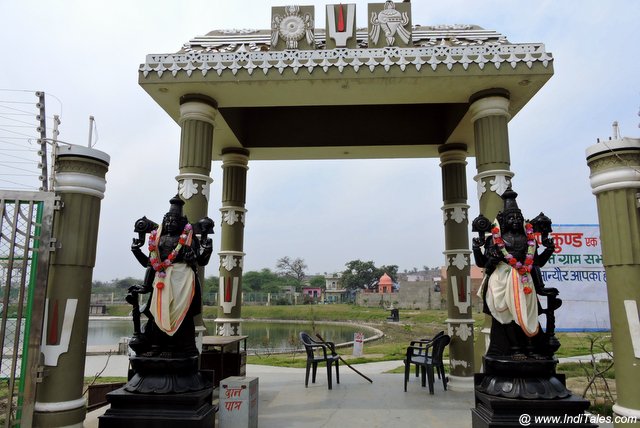
Sankarshan Kund
Sankarshan is another name for Dau Balram, the elder brother of Sri Krishna. This Kund has a lovely image of Balram at one end and two Dwarpalas in stone stand on either side of a gate. Boards in sandstone tell you the story of this Kund, that connects it to Patal Lok and Sesh Naag. A small temple of Balram stands next to the Kund.
Gauri Kund – where Gopika Chandravali used to come and worship Gauri with an intent to meet Krishna.
Neep Kund – where Sri Krishna and his friends made Dona or bowls from the leaves of the Palash tree for eating curd.
Govind Kund – Where Indra did the Abhishek of Sri Krishna after surrendering to him.
Gandharv Kund – Where the celestial Gandharvas sang when Krishna’s Abhishek was being done.

Apsara Kund – Where Apsaras or celestial maidens used to take a bath
Naval Kund – it was originally called Poonchhkund after the Poonchhari village but was renamed Naval after the queen of Bharatpur who renovated it.
Surbhi Kund – Where the celestial Surbhi cow came to give milk to Indra for the Abhishek of Krishna.
Indra Kund – where Indra prayed to Sri Krishna.
Airavat Kund – where the celestial elephant of Indra brought waters from Akash Ganga or the Milky Way.
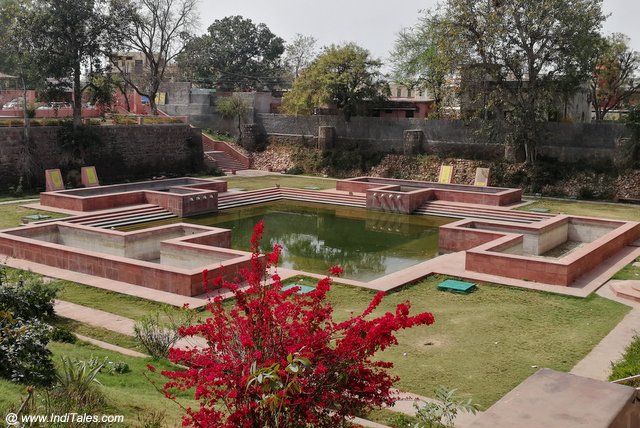
Rudra Kund – Where Shiva as Rudra prayed to have darshan of Krishna
Maad Kund aka Udar Kund – Kund belonging to Maad community
Suraj or Sukhta Kund
Bicchalukund – where Radha Krishna used to play hide and seek.
Uddhav Kund – assume it belonged to Krishna’s cousin and friend Uddhav
Lalita Kund – Located close to Radha Kund, it is named after one of the Sakhis or friends of Radha. In Shakta tradition, Lalita is the supreme goddess and you do see a temple dedicated to her next to the Kund.
Radha Kund & Shyam Kund
Radha Kund is the most important Kund, for Radha is the ruling deity of Braj. Twin Kunds Radha-Shyam Kund are separated by a narrow strip and beneath the strip, the latter feeds the former.

Radha Kund, they say was dug by Radha herself with her bangle, but it had no water. While Shyam Kund has the water from all holy rivers and oceans, and the same water-filled Radha Kund as well. This comes wrapped in a love story that is best listened to standing on the narrow strip between Radha Kund and Shyam Kund.
Kusum Sarovar
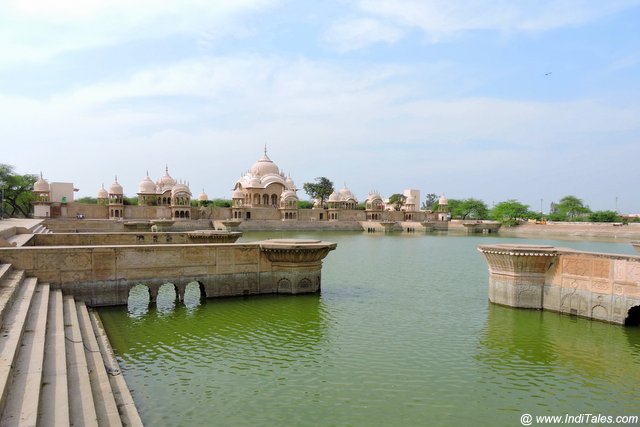
The Kusum Sarovar is the most beautiful and the best-maintained pond here. The canopies at the other end reflecting in its quiet waters create a lovely and soothing image. There is something royal and humble about this Kund. I was there during the day, with the sun shining on my head and its waters, it still looked stunning.
A Shivalinga looks at the Sarovar, built by the royal family of Rajasthan.
However, the flowers that the name ‘Kusum’ promises are not to be seen anywhere.
Chandra Sarovar
This is a little off the main Parikrama Marg. It is believed that at this spot, the moon stopped to enjoy the Ras Lila of Sri Krishna. What makes it an important place to visit is that it is the place of Surdas – the famous 16th CE Bhakti poet.

His samadhi exists in the form of a small temple and you can still hear the students here singing his poetry. Visiting Surdas brought back the poetry I had read in school- Maiyya Mori Mein Nahi Maakhan Khayo!
Villages on the Govardhan Parvat Parikrama Marg
You pass through many small villages on the Parikrama Path, each with its own story of Sri Krishna. Some key ones are:
Aanyaur
This is the original village of Srinathji of Nathdwara used to live. His original temple and the Murti were here in a temple on the Parvat. During the Mughal invasion, this Murti was taken from here to Agra and from there to Nathdwara near Udaipur. A small Braj-like environment exists in Nathdwara where Srinathji continues to live.
Aanyaur gets its name from Aan + Aur.
Sri Krishna lifted the Govardhan Parvat for 7 days. After that, he was very hungry. In fact, 56 Bhog comes from the calculation of these 7 days. A day in India is divided into 8 Prahars, so 8X7 = 56. So, the people of Braj prepared 56 meals for him, one for each Prahar. However, he was so hungry that he kept asking for more – Aan Aur in Braj Bhasha. This is how the village gets its name.
Poonchhari
3 Km south of Aanyaur village is Poonchhari village. It is famous for the Poonchhari ke Lautha Ji ka Mandir. Now, who is this Lautha Ji?
He was a friend of Sri Krishna. They used to practice wrestling together as kids.
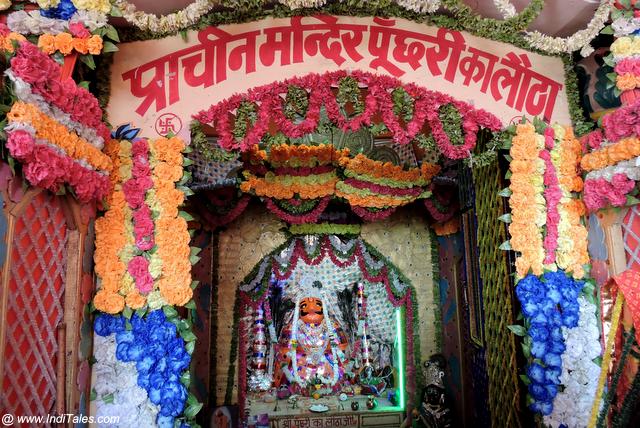
When Krishna had to leave Braj Bhumi for Dwarka, he asked Lautha to come along. Lautha however, did not want to leave Braj Bhumi. He said, he would live without eating or drinking anything till Krishna returns. Krishna blessed him that he would live a healthy life even without eating.
We know that Krishna never came back to Mathura, once he left it. People believe that Krishna will come back one day for Lautha, and he is worshipped at his temple in Poochhari village.
It is a small but very lively temple, where lots of people come to ask for their wishes. Murti here does look like it is a Pahalwan or a wrestler with a big mustache.
Jatipura – Mukharvind
It is a small village that is best known for the Mukharvind temple. At the open temple, a huge rock is worshipped by the devotees by offering it milk. Rock is decorated or Shringar is done differently at different times of the day. The narrow lane leading to the temple is full of vendors selling milk. A scene of Krishna lifting the mountain is depicted on top of the hill.

Jatipura gets its name from the Jyoti or illumination of the Srinathji when he was eating.
Next to the Mukharvind temple, on top of the hill is the Gopalji temple where the Srinathji Murti originally was. People of the village still believe that Srinathji still comes back here to sleep after Sandhya Arti in Nathdwara. This means Jatipura is on the other side of Aanyaur village, across the hill.
A little ahead Sri Giriraj Dandwati Shila which is again a part of Giriraj Parvat is special. 7 rounds around it are equivalent to the holy hill. So, if you cannot walk the whole 21 km, this is your shortcut.
Sakhitada – This is the village of Chandravali – a Sakhi of Sri Krishna.
The shape of Govardhan Parvat
People here connect the shape of the Parvat with that of a cow. Different points of the parikrama are connected with different parts of the cow-like Poonchhari village with its tail. However, some think it is a standing cow, and others think it is a sitting cow and the locations change accordingly.

No matter what you choose to believe in, what you know is that Govardhan Puja is nothing but Gau Puja. Krishna and Cow cannot be separated.
A book I read also suggests that it’s in the shape of a dancing peacock. Well, this bird is also associated with Krishna.
In between temples and Kunds, the path passes through small forests with trees that were mostly dried in March. The hill itself looks like a pile of big stones. Here and there you will see smaller stones balanced on top of each other. This is something you see across cultures near the hills and mountains.
Story of Giriraj Parvat
The story of Krishna lifting the mountain is well known. Krishna wanted the Brajwasis or the people of Braj not to worship Indra. Indra replied by making it rain heavily. Krishna then lifted the Govardhan Parvat on his little finger for 7 days to give shelter to people. After 7 days, Indra’s pride was broken and Krishna’s supremacy was established. The whole of Braj celebrates this event as if it happened yesterday.
Hanuman & Braj
Yet another story that links it to Treta Yug or the time of Sri Ram. When the Ram Setu was being built at Rameshwaram for the army of Sri Ram to cross the sea, monkeys were picking up mountains to make the bridge. Hanuman was carrying a mountain from the Himalayas.
In the meantime, the Ram Setu was built and Nal & Neel, the architects of the bridge announced that no more stone was needed. They instructed everyone to keep the hills in their hands wherever they are. You guessed it, Hanuman was at Braj Bhumi and this is where he kept the hill, before moving on to Sri Lanka.
This story links the stories of the 7th and 8th Avatars of Vishnu – Ram & Krishna. It makes the Govardhan hill even more reverential for it is associated not just with one, but two avatars of Vishnu.
Rules for Govardhan Parvat Parikrama
- Do not climb on Govardhan Parvat. The hill is considered sacred.
- Keep the hill on your right as you walk. Do not show your back or your feet to the sacred hill.
- Do not wash your feet in any of the ponds, taking a bath is permitted.
- Keep quiet & do not engage in worldly conversations. Basically, focus inside rather than outside.
- Start the Parikrama by worshipping at a temple and repeat it after you finish.
Travel Tips for Govardhan Parvat Parikrama

- It is advised that you do the parikrama in a day if you are doing the normal Parikrama by walking.
- People do split it up into 2-3 days if they can not walk 21 km in one day. If you do not have time and energy, take an e-rickshaw and they will take you around in an hour with all stops at the temples.
- Ideally, you should walk barefoot. If you can’t, there are soft sleepers available at shops here for as low as Rs 50/- that you can wear and walk.
- Water, Juice, and food are easily available on the parikrama route. You can walk as light as you want. Do cover your head, for the sun can get really strong during the day.
- Start as early as possible, it would help you avoid the sun.
- The place does have new-age resorts coming up. So, if you plan this trip for this parikrama, it may be easier to stay there. Mathura is about 25 km from here and so is Vrindavan.






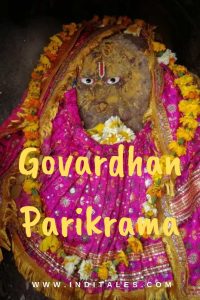
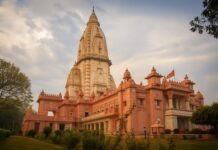
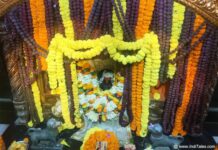






Thank you for sharing such informative blog.
awesome place……thanks to exploring this holy place.
Nice Blog, Thanks for sharing with us !
Nice blog and nice Place
Very informative blog
comprehensive and astute observations
Very very useful information, wonderfully descried that too in short and in lucid language.
Thank you Dr. Desai. Your appreciation helps us do more.
I have a 6 year old child , how to take care of him when i am doing parikrama ?
You can do the parikrama on an e-rickshaw with your 6-year-old.
Blog keeps great information about Govardhan parvat and Parikrama.
Very Nice,detailed & accurate,information which will be of Great help to all the devotees,intending to do this Holy Parikrama.
Many thanks to the author of this Great Blog.
Thanks & Regards,
Shrineevas
Great work! even the minute information are given clearly. The presentation of the page is also very pleasant and appealing! thanks a lot for sharing these valuable travel vlog of my favorite place of my favorite lord! It offered a great hand to me in the process of knowing about the Govardhan parikrama! Thanks a lot from the bottom of my heart friend!
RADHAKRISHNA!!!
I want to visit Govardhan Temple and do Parikrama. 1, Could you please advise from which Temple I Should start Parikrama and End at which temple? 2, Is walking Parikrama or E Rickshaw advisable to do parikrama?3, What will be the cost of E Rickshaw Per Person to complete Parikrama?. Thanks in Advance
Thankyou for this invaluable information. It gave a very good picture. Any suggestions on where to stay ?